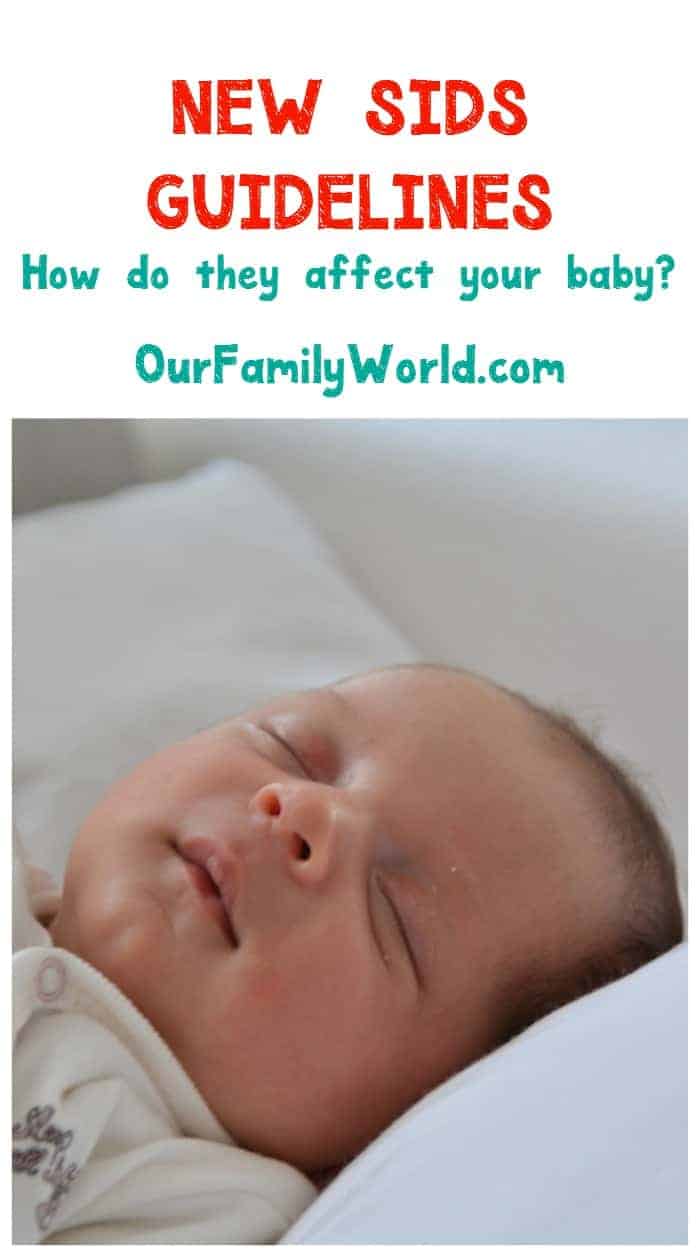
If you saw the updated information from the American Academy of Pediatrics, you might be wondering “how do the new SIDS guidelines impact me and my baby?” Believe me, it’s something we’ve all been thinking about! For many moms, the minute they find out they are pregnant, the worrying begins. Am I eating the right things? Am I taking the right supplements? Should I limit my physical activity? You get through your 40 weeks (give or take), your sweet little one arrives, and the worry you felt during pregnancy is magnified. Is she gaining enough weight? Is he having enough messy diapers?
Then comes the fear of SIDS. I have a friend who was so fearful that for the first several nights her son was in his own room, she set up camp in the doorway to make sure he was alright. Some of you may think that’s extreme, and others of you may think, “Yep; I know exactly how she felt.” The scariest part? Just when we think we’ve got it all down, the rules change and new SIDS guidelines come out telling us that everything we’ve been doing is all wrong.
How do the New SIDS Guidelines Impact You and Your Baby?
The American Academy of Pediatrics just updated their SIDS guidelines to include the recommendation that babies sleep in their own sleeping space in their parents’ bedroom for at least the first 6 months, but ideally the first year of life. They go on to acknowledge “that parents frequently fall asleep while feeding the infant. Evidence suggests that it is less hazardous to fall asleep with the infant in the adult bed than on a sofa or armchair, should the parent fall asleep.”
The parenting forums I’m part of have been aflutter since these new guidelines came out, but when I read them, I felt a sense of relief! The AAP’s SIDS guidelines in the past have completely ignored the fact that co-sleeping is not always a conscious choice – sometimes it is simply a bi-product of sheer and utter exhaustion during middle-of-the-night feedings. What can you do to adhere (as closely as possible, anyway) to these new guidelines?
- Use a bassinet or co-sleeper that attaches to your bed. If you have a safe sleeping surface right nearby, chances are better you’ll transfer your baby to it after those middle-of-the-night feedings.
- Clear blankets and pillows from your bed. Use one pillow behind your back and a firm nursing pillow like a Boppy or My Breast Friend under your baby. That way, if you do fall asleep while sitting up, your baby is resting on a firm surface. All other blankets and pillows should be cleared from the area on the bed where you’re sitting or lying.
- Sit on the edge of the bed or nurse standing up. If you are really worried about falling asleep, make yourself as uncomfortable as possible before you nurse. Some of those really long nights, I would nurse my baby while walking around the house. It certainly kept me from falling asleep!
- Feed on the floor. Sometimes I wanted to watch TV while I nursed, but I also didn’t want to sit on the couch in case I fell asleep. I would carry my baby out to the living room, and sit on the carpet with my back against the sofa. I was low enough to the ground that if I did fall asleep and somehow adjusted positions without waking myself, my baby would safely end up on the floor with me.
- Set an alarm. Get in the habit of setting your alarm for 20-30 minutes after you wake up to start nursing. If you do happen to fall asleep, the alarm will wake you so you can put your baby back in bed.
Hopefully, these tips will help you feel more comfortable with the new guidelines, but if you still want more support, have an honest conversation with your pediatrician. He or she may have additional suggestions for you that could work for your family (make sure to share those suggestions with us in the comments as you learn them!). For more recommendations on keeping your sleeping baby safe, click here.

This is an interesting addition to the research on the subject of Sudden Infant Death Syndrome (SIDS).
Some of why it happens remains a mystery as some babies pass away in their cribs even when an attentive parent has taken all the precautions.
I also still believe the first step is parental education and vigilance.
Eliz Frank
Being a mom of two, I know the worries & fears we all have to go through once your pregnancy is confirmed. With so many health issues we have these days, these new SIDS Guidelines could come handy for many moms for sure!
I remember being so paranoid when my daughter was born. SIDS is so real!
Wow – very useful information! Although I don’t have any little ones, I heard about SIDS at a very young age and it freaked me out when my sister was a baby. I’ll definitely remember these tips when it’s my time to have a little one!
I chose to cosleep when necessary for whatever reasons feeding or otherwise because I had to get up and go to work. I’ve never regretted that choice with either of my boys.
It’s good to know that the SIDS new guideline is available for new mothers. Thanks for sharing this info
The rules were all so simple back when I raised kids, sure they got a little harder 8 years ago with the youngest but my how times have changed. Glad you shared this information!
SIDS is a real thing that people wake up to. When I had babies it was more about sleeping on backs
It’s so scary to be a new parent and try to do what is right in every situation…while totally sleep deprived and feeling slightly insane. I do think the new guidelines just make sense though.
I must admit, I slept with my daughter in bed and on the couch or neither one of us would ever have gotten any sleep. Glad we survived okay!
I met a dad that fell asleep holding his baby in his arms and she rolled and suffocated. It was so sad, I felt terrible for the whole family. He was just trying to be a good dad. These are great tips!
That was a fascinating video. There seems to be so many things I “think” are right, but are warned against, here. Thank you for posting this. I believe it’s going to help a lot of people!
Didn’t realize there were new guidelines. The feed on the floor thing “floors” me. Seems like it would be so uncomfortable!